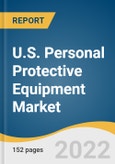The U.S. personal protective equipment market size is anticipated to reach USD 32.5 billion by 2030, registering a CAGR of 6.7% during the forecast period. The market is driven by increasing spending on worker safety and protective products coupled with rising awareness about stringent safety rules & regulations.
The U.S. is one of the most severely affected countries in the world by the coronavirus. The rapid spread of COVID-19 in the country has increased the demand for personal protective equipment (PPE), especially in the healthcare sector, to reduce further transmission. Thus, the COVID-19 outbreak had a positive impact on the growth of the U.S. personal protective equipment market.
Increasing awareness among the industry participants regarding the importance of worker safety and security at workplaces, on account of the stringent regulations and high costs associated with workplace hazards, is anticipated to drive market growth. Particularly, rising awareness along with new rules & regulations in the U.S. are likely to fuel the market growth during the forecast period.
Government regulations such as ANSI, NIOSH, and ASTM compel the use of protective equipment for workers in end-use industries such as oil & gas, mining, and construction. Mandated policies by agencies for companies to maintain worker safety in industries are anticipated to drive demand for personal protective equipment.
Increasing onshore and offshore drilling activities coupled with rising shale gas production in the U.S. are the factors anticipated to augment PPE demand to protect employees from workplace hazards. Furthermore, high product penetration in the U.S. is attributed to the stringent regulatory scenario and growing employee awareness regarding personal safety.
Key players such as 3M, Honeywell International Inc., and DuPont actively focus on product innovation, joint ventures, mergers, and acquisitions. In May 2022, 3M announced expanding production for personal protective equipment such as respiratory and hearing protection products. This expansion will allow 3M to increase investment to meet the unmatched demand for PPE.
This product will be delivered within 1-3 business days.
The U.S. is one of the most severely affected countries in the world by the coronavirus. The rapid spread of COVID-19 in the country has increased the demand for personal protective equipment (PPE), especially in the healthcare sector, to reduce further transmission. Thus, the COVID-19 outbreak had a positive impact on the growth of the U.S. personal protective equipment market.
Increasing awareness among the industry participants regarding the importance of worker safety and security at workplaces, on account of the stringent regulations and high costs associated with workplace hazards, is anticipated to drive market growth. Particularly, rising awareness along with new rules & regulations in the U.S. are likely to fuel the market growth during the forecast period.
Government regulations such as ANSI, NIOSH, and ASTM compel the use of protective equipment for workers in end-use industries such as oil & gas, mining, and construction. Mandated policies by agencies for companies to maintain worker safety in industries are anticipated to drive demand for personal protective equipment.
Increasing onshore and offshore drilling activities coupled with rising shale gas production in the U.S. are the factors anticipated to augment PPE demand to protect employees from workplace hazards. Furthermore, high product penetration in the U.S. is attributed to the stringent regulatory scenario and growing employee awareness regarding personal safety.
Key players such as 3M, Honeywell International Inc., and DuPont actively focus on product innovation, joint ventures, mergers, and acquisitions. In May 2022, 3M announced expanding production for personal protective equipment such as respiratory and hearing protection products. This expansion will allow 3M to increase investment to meet the unmatched demand for PPE.
U.S. Personal Protective Equipment Market Report Highlights
- The head protection equipment is expected to witness growth at a CAGR of 8.1% during the forecast period owing to the increasing instances of brain injuries across various industries such as construction, mining, oil & gas, and manufacturing
- Demand for PPE in healthcare accounted for 34.9% share of the country revenue in 2021 on account of rising demand for hand protection, respiratory protection, and protective clothing to ensure the employees’ safety during the COVID-19 pandemic
- Hand protection is estimated to witness growth at a CAGR of 5.6% from 2022 to 2030 in terms of revenue owing to the increasing adoption of gloves to limit the spread of the COVID-19 infection through surface contact
- The demand for PPE in the chemical industry in the U.S. is estimated to witness growth at a CAGR of 7.5% from 2022 to 2030, in terms of revenue, on account of the product's ability to prevent injuries or burns to the skin, face, hand, respiratory system, and head
- Market for the U.S. personal protective equipment is characterized by the presence of well-established players that have a broad product portfolio, extensive distribution networks, and large financial capacities, which is expected to restrict new entrants
This product will be delivered within 1-3 business days.
Table of Contents
Chapter 1. Methodology and Scope
Chapter 2. Executive Summary
Chapter 3. U.S. Personal Protective Equipment Market Variables, Trends & Scope
Chapter 5. U.S. Personal Protective Equipment Market: Product Estimates & Trend Analysis
Chapter 6. U.S. Personal Protective Equipment Market: End-Use Estimates & Trend Analysis
Chapter 7. U.S. Personal Protective Equipment Market - Competitive Analysis
Chapter 8. Company Profiles
List of Tables
List of Figures
Companies Mentioned
- Honeywell International Inc
- Lakeland Industries, Inc.
- Dupont
- 3M
- Ansell Ltd.
- Avon Rubber plc
- Uvex Safety Group
- Radians, Inc.
- Alpha Pro Tech Limited
- Mine Safety Appliances (Msa) Company
Methodology

LOADING...
Table Information
| Report Attribute | Details |
|---|---|
| No. of Pages | 152 |
| Published | November 2022 |
| Forecast Period | 2022 - 2030 |
| Estimated Market Value ( USD | $ 19.37 Billion |
| Forecasted Market Value ( USD | $ 32.5 Billion |
| Compound Annual Growth Rate | 6.7% |
| Regions Covered | United States |
| No. of Companies Mentioned | 10 |









